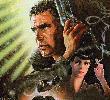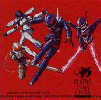



The settings of both Blade Runner and Bubblegum Crisis are very similar. Both feature a well known city set in the 21st century, Los Angeles and Tokyo respectively. The air is polluted, the city is overcrowded, giant buildings dominate the skyline, and advertisement dirigibles float through the streets, casting lights onto the people below. This all too probable bleak hypothesis of city life in the next century is dark, dystopian, and frightening; almost an urban nightmare. In the opening scenes of Blade Runner, bursts of flame escape from industrial towers, forming black clouds that cover the sky. Haze separates the buildings. The scenery of Bubblegum Crisis, though similarly polluted, is not quite as neglected, and is in slightly better shape. In some scenes, the sun is clearly visible in the sky. The sun is only a bright area in the smog filled sky in Blade Runner.
In Blade Runner, the Tyrell Corporation has created an artificial life form, the Replicant. Replicants were created for offworld slave labor, and they match humans in every way, except emotions. Once Replicants develop their emotions, it is found that they become unpredictable and may go berserk. Some may even argue that the Replicants are the only truly emotional characters in the movie, even more than the humans characters are. In Bubblegum Crisis, the Genom Corporation mass produces Boomers for the same uses that Tyrell makes Replicants: menial labor and combat functions. Both Tyrell Corp. and Genom Corp. are guilty of causing grief and suffering due to their careless, greedy motives. Interestingly enough, Replicants and Boomers have their differences. Although they are considered "robots," Replicants are identical to humans, made of flesh and blood. Boomers, on the other hand, have only a human-like exterior, very much similar to the robots in the movie Terminator. Additionally, Boomers for the most part are emotionally inept.
In both Blade Runner and Bubblegum Crisis, the main conflict exists between humanity and its creation. In both stories, the artificial humans are perverted from their original purpose: to serve humanity. In Blade Runner, the Replicants rebel against humanity and kill for their purposes. In the movie, the Replicants are searching to attain a longer lifespan, and they will stop at nothing to live longer than their four year intercept date. Only through carelessness is Tyrell Corp. indirectly responsible for the Replicants' rebellion. In Bubblegum Crisis,, Genom Corp. is responsible for the Boomers' actions, but it cannot be proven. Genom uses the Boomers to wreak havoc in the streets of Tokyo to scare people enough to cause them to move away from the location. Genom then buys the land and expands its facilities. One thing is for certain: it is much easier to stop a Replicant's rampage than it is to stop a Boomer. A special police force, the AD Police (Advanced Police) handles boomer crimes. Similarly, special police squads, known as Blade Runner units, were formed to handle Replicants.
Another compelling theme, present in both shows, is the question of what it is to be human and to have human emotions. Both Blade Runner's Replicants and Bubblegum Crisis's Boomers display a great capacity for emotion, such as Roy and Priss's affection in Blade Runner and Sylvie's compassion for and desire to save Anri in Bubblegum Ciris. Moreover, the viewer will have the same question for both shows: Is Deckard a Replicant? And is Sylvia a Boomer? Both shows leave clues to make one suspect that the protagonist is also an artificial human being.
Apparently, Blade Runner and Bubblegum Crisis are in many ways similar in the aspects of setting, artificial humanity, and conflict. The main thing that sets them apart is that Bubblegum Crisis is heavily influenced by the cyberpunk genre, which is defined by novelists like William Gibson and Bruce Sterling. However, the cyberpunk genre was heavily influenced by Blade Runner, so the relationship is circular. Indeed, both stories provide a pessimistic and altogether sinister look of the years to come in the next century. Sadly, these two fortellings are quite possible.
 Go back to the "Greg's Life" Table of Contents
Go back to the "Greg's Life" Table of Contents
mail: greg -atsign- stevethefish -dot- net